Bill Powelson's School of Drums
School of Drums
* FUNK & FATBACK *
EIGHTH ROCK VARIATIONS, SYNCOPATIONS & FILLS

I will assume that you have already begun to experiment with
simple rock variations like the examples
here.
There are 4.3 billion potential permutations or variations of 8th-note 4/4 Rock.
When we use the street term 'Fatback', we might be referring to any of those patterns.
This means that the term 'Fatback' is a fairly broad description for a lot
of (similar sounding) rhythms.
FATBACK:
Fatback is only a street term, but it is the most common
stage-name being used for these 'largely unnamed' rhythm patterns. The term
'Fatback' hasn't made it into the music dictionaries (yet.)
The term was coined sometime in the mid-1960's, obviously by
some of the older black (soul) musicians of that era. The term caught-on,
and is now used very often on the bandstands around the world, today.
No one seems to know who coined the term.
The drumming term
'Fatback' has become the popular label among rock musicians to
describe a whole series of 8th-note rock variations, and syncopations. The label
'Fatback' has stuck, because of the sound these rhythms make, I suppose.
Anyway, the rhythms we call Fatback, create
a sound that is similar to 'pork rhines' cooking in deep fat.
The blacks call that snack, 'Fatback' . . . it is
considered a soulfood here in the U.S.
Some say the street-term or
on-stage term, 'Fatback', originated because of that.
A DIFFERENT DESCRIPTION . . .
Others say the term 'Fatback' originates as a way of saying that
the BACKbeat, is unusually 'loud' or 'FAT'. In other words, we could say that Fatback
is a rhythm with an unusually strong or . . . 'FAT', 'BACK'beat.
NOTE: The terms 'Funk' and 'Funky' are both referring to these same 4.3
billion permutations of 16th, 8th and 4th rock permutations.
Regardless of which description you prefer,
the rhythmic street-term 'Fatback' is most often used to describe an unknown (or arbitrary) number
of 4/4 syncopations and variations.
If we do a chronological study of Pop, Rock, Soul and Jazz music, it is interesting to
note that since about 1965, four specific 'Fatback' rhythms have predominated
all music styles, and they still do today.
As we listen to the top 100
songs of 1966, we discover that about 20 or 30 of those songs
were based on some form of the four 'Fatback' (8th rock variations & syncs), in this drum lesson.
It has been about the same way every year
since then, as well. This same handful of 8th rock permutations tend to continually
predominate all pop music styles, from rock to jazz, and even C&W music styles.
I think we can safely predict there will be little
difference for many years to come. Fatback is the root
rhythm to a very high percentage of all popular-music styles. Listen to the top 100
songs of last year, and you'll notice about the same ratio.
We drummers need to master all the most popular variations of
those Fatback patterns. Though there are 'technically' more than 4.3 billion
options, (which is a bit daunting), it's a lot easier than that. You'll
learn the bulk of these rhythmic variations in a natural way . . . as needed
in the music, as you jam.
The truth is; As we master these most common patterns, then add a few
snare and/or bass syncs (here, and there), we will create larger numbers of different 'sounding' permutations.
We tend to get the bulk of the more complex patterns, almost automatically and naturally. They're really these same
four beats with an added bass or snare, (here and there.)
I will show you the most popular
8th-note 4/4 'Fatback' rhythms, here in this lesson. For
simplicity, I will take the liberty to label them
Fatback #1, #2, #3 and #4. You should try to memorize all of
these beats. You will hear them over & over again in nearly any
music you may favor. Then as you continue to listen, jam, and learn,
you'll progress in a totally 'natural' way. The more complicated of these patterns will emerge almost automatically,
as needed, within the music you are routinely playing.
Don't scoff at this (teaching/learning) tactic! This is really the way most working drummers learn
to play these patterns. Believe it!
The difference between the wannabe drummer and the working-drummer,
is directly proportional to the amount of time devoted to jamming with actual music! You WILL learn at accelerated
rates, in a totally natural way . . . as you jam with music.
If you do not
jam with music, (for the LOVE of it) . . . you may never gain this easy-learning
trick, I'm trying to instill into you. For every 20 minutes you devote towards
studying a lesson like this one . . . you should also devote another hour or more
towards jamming with all sorts of recorded music, (for the fun of it.)
Much of this should come natural, as you jam with more and more rhythmically
complex music styles.
If you've studied the 4 basic Fatback patterns (below), and
if you are comfortable with bass and snare syncs (below), you'll get the rest
by proxy, or automatically. The combined knowledge below will all merge (naturally) into
hundreds of other, similar but unique, rhythms.
You'll eventually get to
a point where you'll be able to instantly and automatically play whatever is needed in
the various songs, as you jam, (without studying each and every possible permutation
on paper.)
I'll say it again, though I'm sounding like a broken
record. It's all about JAMMING with a hugely diverse array of music
styles. Do that, and everything I'm saying here will become
obvious. I'll predict easy successes for you.
If you do not jam with music for the love of it, most
of this may never make much sense.
FATBACK #1:
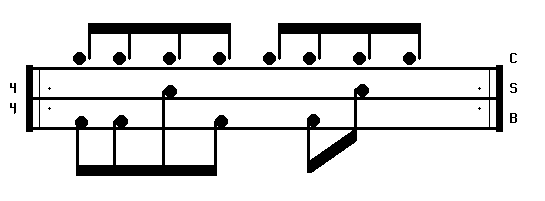
 This is the Fatback pattern we learned on the main webpage.
This is the Fatback pattern we learned on the main webpage.
 VIDEO: Click here to 'Play', see, and hear the above Fatback variation, video.
VIDEO: Click here to 'Play', see, and hear the above Fatback variation, video.
FATBACK #2:
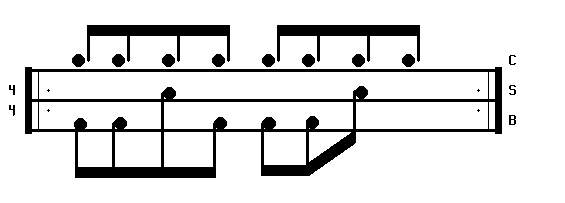
 Hear it! Learn it! You will need it!
Hear it! Learn it! You will need it!
FATBACK #3:
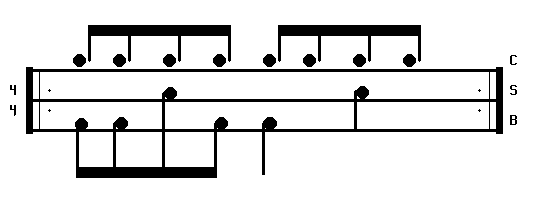
 Listen & Learn!
Listen & Learn!
 VIDEO: Click here to 'Play', see, and hear the above Fatback variation, video.
VIDEO: Click here to 'Play', see, and hear the above Fatback variation, video.
FATBACK #4:
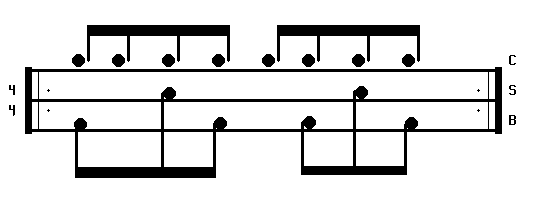
 This one sounds much different than it looks!
This one sounds much different than it looks!
After learning these 'simple' Fatback (aka; 'Funk') patterns, you should learn a little
about adding snare syncopations to 8th-note Rock and Fatback here.
Be sure to
visit and study that lesson before completing the remainder of this E-M lesson.
You will learn to add snare syncopations (syncs) to Fatback and other Rock variations.
You are learning some of the most difficult maneuvers in drumming. I can promise that your effort will not go unrewarded. Once you master snare syncs and bass syncs, your playing ability will grow by leaps and bounds. This is where you will learn to play all the really neat 'funky' beat patterns.
Devote considerable time to the beats in these lessons. After gaining control with these, your imagination will begin to take over. Hopefully,
within a few weeks of diligent effort, hundreds of new beat patterns should begin to occur as if by magic. Much depends on the amount of effort expended, and also how closely you listen to the recorded drummers within your favorite music. I am not particularly fond of 'Rap' music, but it is often riddled with syncs like the ones we are touching on here.
I will step up the pace a little below. If it seems
impossible to do this stuff . . . the fault will be mine. Don't blame
yourself! It's VERY COMMON for even the best students to encounter difficulties
with this material below. Think in terms of weeks and months, rather than hours
and days, as you learn all this. It takes time to gain the expertise that will
come from this knowledge.
Since I'm sorta shooting in the dark . . . (remember, I haven't heard
you play); It may happen that the pace may be too fast. Slow down, jam,
have fun, and be patient. These techniques will evolve slowly as you listen, jam,
and learn.
LEARNING TO PLAY
BASS DRUM SYNCOPATIONS
WITH 8TH-NOTE ROCK
Are you into bass syncs yet? There are literally billions
of these patterns (approx. 2.15 billion) and they can take you to
unexpected levels almost overnight. If your aren't playing them
already, I predict that many of them will become your favorite beats
within the next few weeks or months!
Bass syncs may be used in any of the dance beat categories, but
the best ones occur within the 8th-note rock beat.
SYNCOPATION:
Look up the word syncopation in the dictionary. It gives a
pretty broad description of the term. For our purposes, (from
the drummers perspective) . . . a syncopation is when we play a
snare or bass note between any of the steady cymbal notes.
BASS SYNCOPATIONS:
Example A:
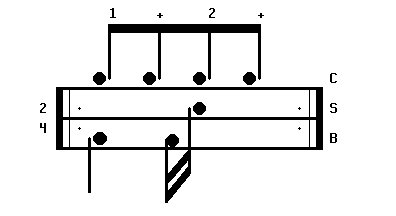
 Hear it & Play it!
Hear it & Play it!
 VIDEO: Click here to 'Play', see, and hear the above Bass Sync, Example A., video.
VIDEO: Click here to 'Play', see, and hear the above Bass Sync, Example A., video.
The second bass drum in the above example is 'between the
cymbals' or syncopated. Your right hand will naturally want to
hit with that 2nd bass. Do not allow it. Fight to separate the
bass from the right hand. This is the beginning of some very
complex and popular rock patterns. If it is too easy then move
ahead. If it seems totally impossible, move to the second part of
this note for easier ways to approach the concept.
Example B.
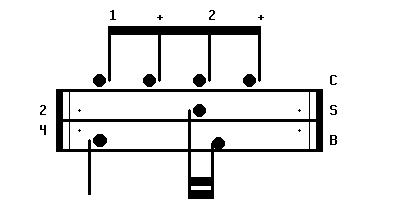
 Similar beat but with a twist.
Similar beat but with a twist.
 VIDEO: Click here to 'Play', see, and hear the above Bass Sync, Example B., video.
VIDEO: Click here to 'Play', see, and hear the above Bass Sync, Example B., video.
Remember, these are repeating patterns! The cymbal line
will remain constant throughout the entire procedure as you play
the beats over and over.
Example C.
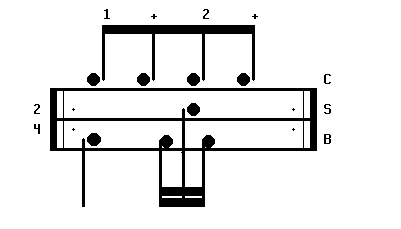
 Hear it!
Hear it!
 VIDEO: Click here to 'Play', see, and hear the above Bass Sync, Example C., video.
VIDEO: Click here to 'Play', see, and hear the above Bass Sync, Example C., video.
These patterns are much
easier when you can hear the way they should sound. Just
trust the ol' teacher on this one. If these patterns are new and
difficult, then maybe I have hit the mark . . . just keep trying
until you are certain they are impossible, heheh. (Section 2 of
this lesson is designed to develop more gradually, if that IS the
case).
Bass Syncs are EXTREMELY valuable and well worth the effort
required. You will climb to new levels of ability in a very short
time once these and a few other similar patterns have been mastered.
As extra practice, try injecting these patterns randomly
into a basic rock beat in progress . . . then into your favorite
(slower rock) music. After studying and memorizing these ideas,
you will be amazed to discover how often they turn up in the very
songs you have been practicing with. I am predicting that these
are the beats that may have caused you some self-doubt in the past.
========== SECTION TWO ==========
The objective is to teach the foot to do one thing while the right
hand does something else.
You will need to study these patterns at a snails pace in the
beginning . . . your speed will increase as you gradually gain control
and develop special coordination with your foot.
An interesting bit of good news. As you gain control with rock
syncs, you will find that it is easy to transfer the same general
techniques to the blues beat and all other dance beat patterns.
******************
MORE BASS SYNCS . . .
BASS SYNC EXERCISES:
The two exercises that follow should develop your foot even further.
These two patterns appear very simple at first glance. Don't let that
fool you . . . it may take several weeks to push them to maximum speed.
They are extremely important! Many of the hottest rock beats will be made
up of these two patterns. Start very S L O W L Y and build speed over
several hours of persistent practice.
EXERCISE #1:
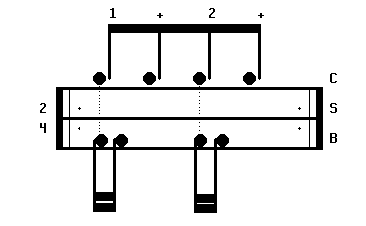
 The faster you can play this, the sooner you will reach new plateaus.
The faster you can play this, the sooner you will reach new plateaus.
 VIDEO: Click here to 'Play', see, and hear the above Bass
Syncopation variation, video.
VIDEO: Click here to 'Play', see, and hear the above Bass
Syncopation variation, video.
The first bass is with the cymbal . . . the second bass is very quick
but between the cymbal notes. The cymbal is constant and there is no snare
note in these two exercises.
EXERCISE #2:
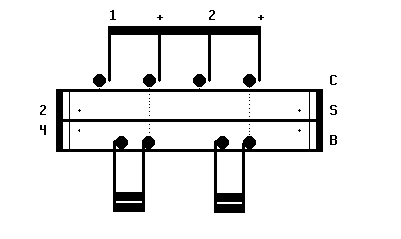
 Listen & memorize!
Listen & memorize!
 VIDEO: Click here to 'Play', see, and hear the above Fatback variation, video.
VIDEO: Click here to 'Play', see, and hear the above Fatback variation, video.
In the above pattern the syncopated bass is falling before the cymbal
while the second bass is with the cymbal.
Syncopated Beat: This beat uses everything we have learned so far . . .
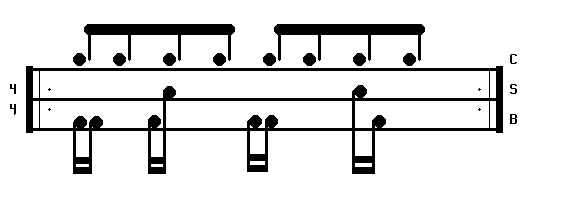
 Nice & Funky!
Nice & Funky!
 VIDEO: Click here to 'Play', see, and hear the above beat variation, video.
VIDEO: Click here to 'Play', see, and hear the above beat variation, video.
EXTRA PRACTICE: This will become your favorite beat, if you have the stamina to master it!
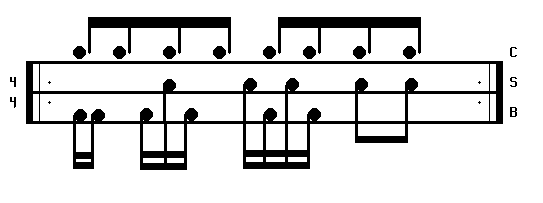
 Hear it!
Hear it!
 VIDEO: Click here to 'Play', see, and hear the above Fatback variation, video.
VIDEO: Click here to 'Play', see, and hear the above Fatback variation, video.
FILLS & ROLLS
Of course, any fill or roll pattern may be used with the above
techniques. To learn more about adapting fills to 8th-note Rock,
see the following lessons:
Rudiments, Rolls & Fills: Part I
Rudiments, Rolls & Fills: Part II
 Copyright Bill Powelson 1994 all rights reserved.
Copyright Bill Powelson 1994 all rights reserved.



